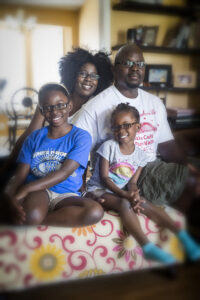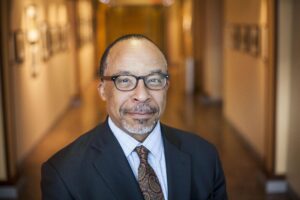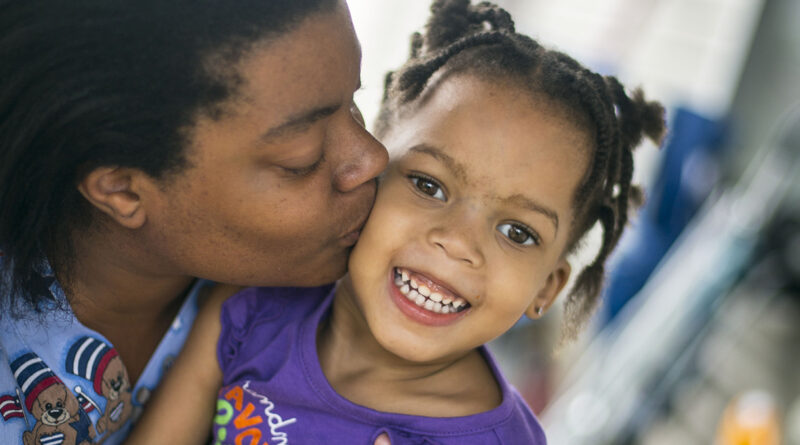Care for Life
Published on September 9th, 2014 by user.
Naazirah Thomas and her mom, Marissa, make the trek from Clarksville to Nashville every two months because the customized, comprehensive health care the toddler needs is not available in her hometown.
Naazirah has sickle cell disease, an inherited blood disorder that affects the red blood cells. The disease can cause pain episodes, often in the arms, legs, chest, back or abdomen. Continuous sickle cell issues can lead to blood vessel damage and injuries to organs in the body.
“I was definitely sad when I found out she had it. I felt it was my fault, but I had to get myself out of that mindset,” said Marissa. “It’s something she’ll have for the rest of her life. You want your child to be healthy and to have the best.”
In the United States there are an estimated 100,000 people—adults and children—just like Naazirah, searching for the comprehensive care they require for their chronic, lifelong condition. The disease most commonly affects African-Americans, occurring in one out of every 396 births.
In patients with sickle cell disease, the red blood cells are abnormal—hard, sticky and shaped like a crescent moon. When the sickle cells travel through small blood vessels, they can get stuck and clog the blood flow. This causes the pain episodes.
Naazirah’s pain can be difficult for Marissa to watch as her normally bubbly, playful 3-year-old transforms from a singing, prancing toddler to a tearful patient.
“One time I almost cried with her,” Marissa said. “She was screaming and she didn’t want me to touch her. She just wanted to lie there in a ball.”
The Vanderbilt-Meharry-Matthew Walker Center for Excellence in Sickle Cell Disease, launched two years ago, has changed the way providers care for children and adults with sickle cell disease and asthma, offering an innovative care model that seeks to provide the best, all-encompassing care over the life spectrum—under one roof in a community setting. This method of care is known as the medical home model.
Since no two patients—young or old—are alike, the center focuses on each patient, personalizing their treatment and getting patients involved in their own care. Routine checkups and maintenance care help ensure patients like Naazirah can prevent pain episodes or overcome them quickly.
The center is led by Michael DeBaun, M.D., MPH, an internationally renowned expert in sickle cell disease who has done extensive research on the disease.
Given that children and adults with sickle cell disease can average six to nine health care visits a year with multiple providers, the medical home seeks to offer a one-stop, streamlined solution to coordinated care.
“Our premise of the medical home is that we will help improve patient adherence to appointments and improve the overall care and decrease the burden to the family and decrease costs to the system. We have integrated three health care teams working side by side in a community health center: a primary health care team from Matthew Walker Comprehensive Center, Vanderbilt’s specialty care in children with sickle cell disease and asthma, and Meharry Medical College Hematology focused on adult sickle cell disease care,” said DeBaun, J.C. Peterson, M.D., Professor of Pediatric Pulmonology and professor of Pediatrics.
The center is a partnership between Vanderbilt University, Meharry Medical College and Matthew Walker Comprehensive Health Center, a Federally Qualified Health Center.

The clinic, housed within Matthew Walker, has all the usual components: scales for weighing patients, stethoscopes to listen to hearts, exam tables, etc. But it’s anything but typical; it’s pioneering.
Set within a community neighborhood in Nashville, the center employs the medical home model, designed to offer integrated, family-centered care by bringing together adult and pediatric physicians, specialists, nurse practitioners and nurse case managers from Meharry, Matthew Walker and Vanderbilt. The clinic is prepared to handle everything from asthma to depression, a common co-morbidity in children and adults with a chronic disease, such as sickle cell disease.
Marissa Thomas, Naazirah’s mom, says the clinic has provided her with a lot of resources to understand her daughter’s disease and how to best help her.
“They gave me a book on sickle cell and told me signs to look for at home,” she said. “They are working to prevent things from happening to her.”
The umbrella approach of the medical home offers support, educational resources and personalized care, effectively helping to reduce health care costs and improve access for children and adults with the disease, who require long-term treatment.
“That’s the beauty of the medical home model of care—we’re all under one roof. We can take care of the entire family,” said Jeannie Byrd, case manager for the Sickle Cell Center. “We have several patients’ parents who we have identified that do not have primary care providers and in some cases, no health insurance. It is not uncommon for one of our patients to be seen for a sickle cell disease visit, for a sibling in the family to receive the medical care for asthma or for the parent to be seen for primary care. During a visit at Matthew Walker, we can address the family’s multiple health care needs with a single visit.”
Byrd is the person who families call to chat, address concerns or update any other health issues—even if the concerns are unrelated to sickle cell disease.
Having everything in one location is convenient for April Bell and her daughters, Taylor, 8, and Lauryn, 5, who all have sickle cell disease and access multiple providers at Matthew Walker and Vanderbilt. Convenient evening appointments also allow the Bells to keep up with their doctor visits without missing work or school.
April Bell didn’t learn she had sickle cell disease until 2002 when she had a miscarriage. Doctors told her she had the disease. April’s husband, Cameron, is a carrier of the trait, which means he can pass on the disease but exhibits no symptoms.
“Growing up my mother said ‘you just have muscle spasms, you’re doing too much,’” Bell said. “She told my brother the same thing. We later found out he had it too.”
When she found out she was pregnant with Taylor, Bell knew her daughter might have sickle cell too. When both parents carry the sickle cell trait, there is a one in four chance a child will be born with the disease.
“It didn’t hit home until Taylor had her first pain episode at 10 months old,” Bell said. “She was crying out in pain. She was in the hospital for a week. This is when we learned what we were in store for.”
Partnering for better care Care
More than 20 percent of adults and children who have sickle cell disease also suffer from asthma. Read more »
Taylor was in the hospital almost monthly during her first two years of life.
“We learned all the tests, all the medicines. It really wasn’t until she was 3 years old that we were really educated about sickle cell, even for myself. By the time Lauryn was born, we knew what to expect,” Bell said.
Sickle cell disease can vary in severity from one patient to another, depending on which type a patient has. The types include: hemoglobin SS, which accounts for 65 percent of cases; hemoglobin SC, seen in about 25 percent of patients; and hemoglobin S/beta thalaseemia, affecting about 10 percent of the sickle cell population.
Taylor and Lauryn have hemoglobin SC disease.
Individualized pain management plans help control or reduce crisis episodes.
Other risks for patients who have sickle cell disease can include: stroke, asthma, pneumonia, swelling in extremities, spleen complications, vision loss and depression.
The girls have a personalized multi-step plan for pain management. Where the pain starts and how bad it is determines the course of action. The plan encourages them to do all they can with medicine, rest and fluids; all aimed at avoiding a trip to the hospital.
The Center also helps teens make a seamless transition into their adult care by having adult and pediatric providers in the same clinic. Medical advances since the 1960s are helping many children with the disease live into adulthood with their symptoms well controlled. Bell sees an adult provider, Adetola Kassim, M.D., M.S., clinical director of the Sickle Cell Anemia Program, who will also care for her daughters when they eventually switch over to the adult program.

“Dr. DeBaun is big on the girls knowing they have sickle cell, what type they have, and what they can do so they don’t have a pain crisis. That will help them when it comes time to transition,” Bell said.
DeBaun is also working on several research studies to better understand how to best treat sickle cell disease, and translate therapies from the bench to the bedside in the medical home.
He has more than a half-dozen translational or clinic studies in place. One international trial was just completed to address the optimal strategy for managing silent strokes in children with sickle cell disease; he’s also examining how asthma and sleep disorders in sickle cell may lead to increased pain episodes, lung problems and other health issues. A third trial is being conducted in Kano, Nigeria, to determine if hydroxyurea therapy can prevent strokes in young children with sickle cell disease.
Bell said research and education about sickle cell disease has improved, but she’s hoping more can be done. She sits on the advisory board for the Sickle Cell Foundation of Tennessee. The family attends educational events hosted by the Sickle Cell Center such as the back-to-school bash, camps and walks to stay involved.
“The education has increased for the better, but we still have a long way to go—families are starting to talk about it,” Bell said. “It’s something that ran in my father’s family, but we didn’t talk about that. Let’s not be so quiet. Let’s talk to other parents to see how they’re helping their children. We need more research, more treatments for sickle cell disease.”
More research needs to be done to improve the lives of individuals with sickle cell disease. There is only one drug approved by the Food and Drug Administration for sickle cell disease: hydroxyurea.
As part of the research efforts, Vanderbilt and Meharry Medical students are also conducting research with the sickle cell team. Vanderbilt medical student Rachel Wolf, sponsored by the Vanderbilt Medical Scholars Program worked on determinants of enuresis (bed wetting) in children with sickle cell disease; and this year, medical student Leah Vance, sponsored by the Doris Duke Charitable Foundation, is leading a multi-center feasibility trial treating children with acute chest syndrome with inhaled steroids to prevent re-hospitalization, a major consequence of this acute illness
“We have a great team and we work in a great environment. We are all excited about making this medical home model take root and providing the best possible care for the SCD families anywhere in the country,” DeBaun said. “We believe that our unique approach builds on the strengths of the different health care systems in the region to provide family-centered medical care in an efficient way.”




